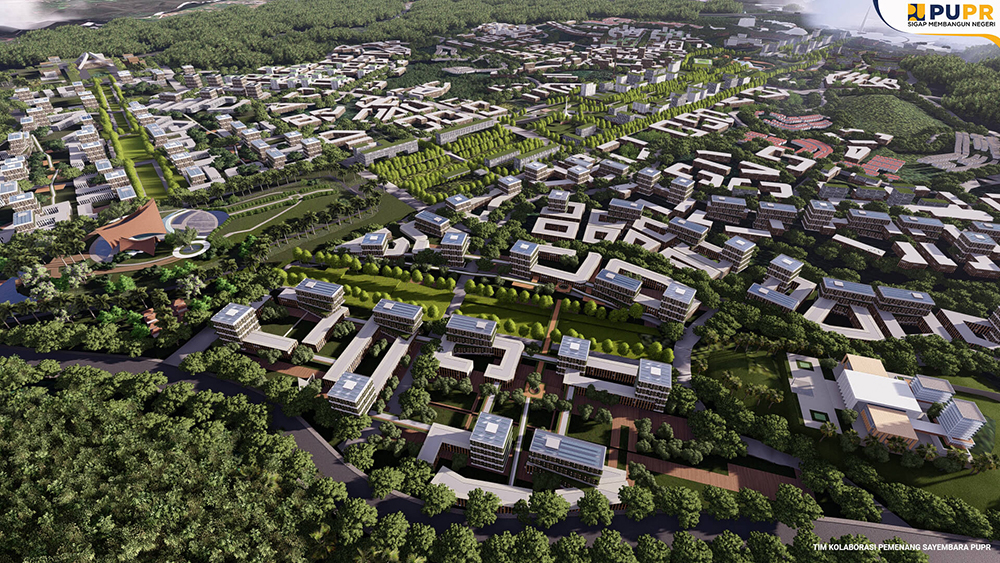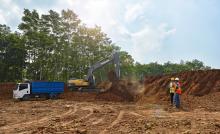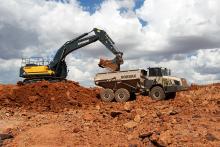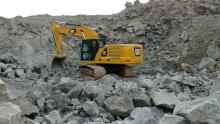
The outlook for the aggregates sector in Indonesia is positive, with demand likely to come from a number of major infrastructure projects across the 17,508-island archipelago of which around 6,000 are inhabited.
Foremost among these projects is the planned US$35bn construction of a new national capital city to be called Nusantara in the East Kalimantan province of Borneo Island.
In plans announced by President Joko “Jokowi” Widodo’s government at the start of this year, Nusantara (Javanese for “archipelago”) will replace the current capital Jakarta which is on the island of Java. The heavily-populated city of Jakarta is rapidly sinking, at a rate of up to 25cm a year in some areas, due to the over-extraction of groundwater.
Gerrit Lambert, head of market Indonesia at Volvo CE, says the Nusantara initiative will be one of the major drivers for the Indonesian aggregates business.
“The Nusantara project is greenfield and will require large amounts of material for road and infrastructure development,” he adds. “Most of these aggregates are sourced from western Sulawesi which is most favourable due to a short sea passage across to Borneo.”

Lambert says that airport, road and port construction is also contributing to aggregates demand, with several new projects ongoing. Notable new airports are at Majalengka in West java and Maleo Airport in Morowali, Central Sulawesi.
Cement manufacturer PT Semen Indonesia estimates that the construction of Nusantara will create a potential demand of 21 million tons of cement over the next 20 years. The company adds that future prospects for the cement sector are also improved by the predicted population growth of approximately 1% a year from the current 270 million, with the accompanying need for more housing and infrastructure.
The country’s construction sector is expected to expand by 7.2% in real terms in 2022, according to data and analytics firm GlobalData, surpassing pre-pandemic output levels and boosting the demand for quarry products.
This would be a notable increase compared to the growth rate of 3.1% recorded in 2021, when large-scale social restrictions and pandemic-related uncertainty deterred new construction investment which consequently impacted construction progress and aggregates demand.
GlobalData says that, following the recovery in 2022, Indonesia’s construction industry is expected to record an annual average growth of 5.8% in real terms between 2023 and 2026. Growth over the forecast period is expected to be driven by the Indonesian government’s commitment to invest US$430bn in public infrastructure development by 2024 and works on the 2021-2030 Electricity Supply Business Plan (RUPTL).
Willis Rooney, economist at GlobalData, comments: “The government is expected to continue its substantial planned infrastructure investment, to offset the economic impact of the current wave of the Omicron variant and an expected normalisation of monetary policy by Bank Indonesia.
“In December 2021, the government allocated US$27.1bn for infrastructure development in its 2022 state budget, which is expected to support the delivery of six new airports, 6,624km of railway and 205km of new road. Construction growth will be further supported by the Indonesian Ministry of Public Works’ plan to expand its 2,000km toll road network to 5,000km by 2024.”
Having been disrupted during much of the first three quarters of 2021, due to the impact of large-scale social restrictions, there has been a noticeable improvement in construction activity.
Rooney concludes: “In Indonesia, GlobalData’s Construction Project Momentum Index (CPMI) accelerated in the final quarter of 2021, rising to 0.49 in Q4 following a CPMI score of 0.3 in Q3 2021. The CPMI is an assessment of the health of the construction project pipeline at all stages of development, from announcement through to completion.
“Project momentum has been relatively subdued during the pandemic, though picked up rapidly in December 2021 and January 2022, following an easing of restrictions. Indonesia recorded the second-highest CPMI score in South-East Asia in January 2022.”
The World Bank classed Indonesia as a lower middle-income country in 2021. In a survey of businesses by Bank Indonesia in April this year, respondents predicted business activity to accelerate in the second quarter of 2022, driven by several key sectors, particularly the mining, quarrying and manufacturing Industries.
The Indonesian economy has been resilient while still affected by the global COVID-19 pandemic, according to Volvo CE’s Lambert.
“Infrastructure projects were put on hold during the onset of the pandemic which has negatively impacted the quarrying and aggregate sector,” he adds. “The sector rallied over the past 18 months, owing to a bullish commodity market, large local population driving demand and increased government spending for infrastructure projects.”
Alessia Valerio, spokeswoman for excavator screener and crusher buckets manufacturer MB Crusher, says that Indonesian quarry operators are currently looking for equipment that is versatile and also reduces the number of tools needed for a job.
“Attachments' popularity is exponentially increasing because they are flexible," she adds. “Some of the key features that are in demand are easy manoeuvrability, compatibility with existing base machines, and the possibility of easily adjusting the performance parameters such as output size.”
In terms of major developments in the Indonesian quarrying and aggregates sector over the next 18 months, MB Crusher’s Valerio says the need for speed is increasingly important. “More materials are needed so there is a need to slimline processes, cutting all unnecessary steps such as moving the material to and from the processing plants,” says Valerio. She adds that excavator attachments, such as those from MB Crusher, provide the flexibility to crush and load a truck all in one simple step, cutting time and costs.
Lambert of Volvo CE says most stone aggregates quarries in Indonesia are small- to medium-sized, and therefore equipment demand is usually centred around 20-tonne excavators with breaker attachments and small 3m3 bucket wheeled loaders to load crushers.
“Rigid haulers, large excavators and loaders are primarily utilised by limestone quarriers for the cement industry,” he adds.
In terms of the major opportunities for Volvo CE’s business in Indonesia, Lambert says the company’s full suite of equipment is well suited to all types of quarry operators in the country.
“Mid-sized construction equipment offers best-in-class fuel efficiency, keeping operational costs down; while Volvo’s heavy mining equipment offers high uptime to keep operations running 24/7,” he adds.
The aggregates industry in Indonesia is experiencing a boom, with over US$104bn invested in road infrastructure in the country. Providing the building materials to satisfy this huge level of investment is a challenge for many companies, but one contractor based outside the city of Yogyakarta on the island of Java, is using a Volvo CE EC200D excavator to help meet demand.
PT Berdikari Putra Perkasa was one of the first in Indonesia to receive an EC200D, with deliveries starting only a few months ago. The unit has replaced an older machine and significantly boosted production for the company, which delivers building materials to projects around the local area.
The EC200D is based at the stockpile facility, playing a central role in operations where it works up to 20 hours a day moving over 300m3 of sand and gravel from quarries to the stockpile. From here the material is moved for processing before passing on to the construction projects where it will be used. Situated at an important bottle-neck between extraction and transport, the excavator’s work is vital for the successful delivery of aggregates to customers.
To boost tourism in Yogyakarta, a major cultural centre, the government has started a range of infrastructure projects including the new Yogyakarta International Airport. With many large projects underway, demand for aggregates is high.
A Volvo CE EC210D excavator is being utilised by building materials supplier CV WiroSobo Sejahtera to support the city’s infrastructure development programme. The company operates a quarry at Gendol River and a separate crushing plant nearby.
Its Volvo EC210D machine is working up to 14 hours a day, shifting 150m3 to 300m3 of material. It removes sand and rocks, and loads them into trucks for transfer to the crushing plant. Periodically, these sand and rock supplies are replenished, as materials that erupt from nearby Merapi volcano are washed into the Gendol River valley.
While these inflows of material are a welcome boost for aggregates producers, it can also make working conditions unstable with the ground prone to movement or inflows of water.
Suroto, the company owner at CV WiroSobo Sejahtera, explains how working conditions can change: “Somedays the EC210D is working in a dry riverbed and others it might be working in water or on ground that has shifted.
“We need a machine that has the power to cope with the changing terrain and that is tough enough to work among so much hard rock and sand. With the Volvo EC210D we have a machine that we know is safe and fuel -efficient - we don’t have to worry about how it will cope.”
Looking at the prospects for the Indonesian quarrying sector over the next 12 months, Volvo CE’s Lambert says the market will see a strong push for major government project completion in the run up to the 2024 presidential election.
“The nickel sector will continue to drive development in Sulawesi and eastern Indonesia, driven by global demand for electric vehicles,” he adds. “There are two major nickel centres in Indonesia, Morowali and Weda Bay. Both of these locations include development of new cities including their own airports, nickel smelting and stainless-steel production facilities which require a large volume of aggregates.”
Indonesia’s cement association, the ASI, says the country’s cement sector is making significant progress in reducing greenhouse gas (GHG) emissions in line with the government’s objectives.
The Indonesian government is committed to reducing GHG emissions by 2030 by 29% or equivalent to 834 million tons of CO2e with their own efforts, and by 41% or equivalent to 1.08 billion tons of CO2e if they get international assistance.
ASI comments: “One proof of the achievement of the cement industry's GHG emission reduction target is the reduction in the intensity of cementitious GHG emissions in 2020 by 641.5 kg CO2/ton cementitious compared to 2010 which was 725.66 kg CO2/ton cementitious.”

The ASI says it continues to encourage increased use of environmentally friendly cement at the national level through outreach. It adds that it also makes approaches to the government to integrate the goals of the cement industry with government programmes in achieving GHG emission reduction targets through the use of environmentally friendly cement in infrastructure projects. ASI says that recent infrastructure projects that have implemented the use of environmentally friendly cement include the Suramadu bridge linking the islands of Java and Madura, and the Steam Power Plant (PLTU) - a 1,900-megawatt (MW) coal-fired power station in Central Java.
The Indonesian cement production sector – the seventh-biggest in the world, according to analyst Statista, with a production capacity of 102.6 million metric tons a year - has been hit by the effects of the Russian invasion of Ukraine. Many companies have experienced difficulties obtaining raw materials previously supplied from the war zone , such as coal. The country’s cement sector has also suffered from overcapacity in recent years with several new producers entering the market.
Indonesian cement producer Indocement, which is majority-owned by Germany-headquartered HeidelbergCement and has a 25.4% share of the local market, booked overall domestic (cement and clinker) sales volume of 18 million tons in 2021, an increase of 853,000 tons (+5.0%) in volume compared with 2020. The producer’s domestic cement sales volume (without clinker) totalled 16.6 million tons, up by 352,000 tons (+2.2%) on 2020. Export sales increased by +122.0% from 181,000 tons to 402,000 tons in 2021, mostly from clinker product from the company’s Tarjun factory.
The company's net revenue increased by 4.1% to IDR14,771.9bn (US$0. 99bn), compared with the 2020 total of IDR14,184.3bn (US$0. 95bn). The percentage increase in revenue was less than the percentage rise in sales volume (+5.0%) due to the lower overall average selling price of export sales.
Indocement says the national cement industry experienced growth again in 2021 although it was still relatively limited. Based on data from the ASI, cement demand in 2021 reached 65.21 million tons, an increase of 4.3% compared to that of the previous year of 62.51 million tons. However, the national cement industry still had a relatively large excess supply of up to 45 million tons.
Cement industry growth in 2021 was driven by bagged cement, contributing up to 77% of the cement market. Indocement says this was due to the limited number of government infrastructure projects, in addition to oversupply in the commercial building market (office buildings and apartments) which meant that new projects were relatively very limited.
Indocement said that in 2021, the cement industry also faced a formidable challenge from the soaring price of coal. In November 2021, the referred coal price from the Indonesian Ministry of Energy and Mineral Resources reached its highest level in the last ten years (US$215.01 per ton), whereas in early 2021 the coal price was in the range of US$75.84 per ton. This has significantly increased the cost of cement production.










